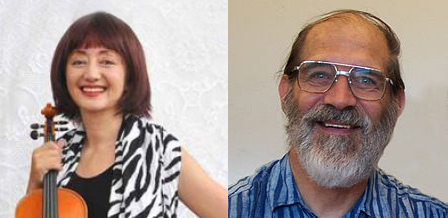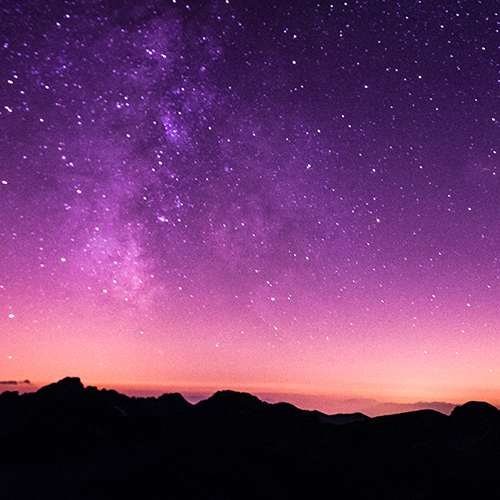Celestial objects have inspired countless masterpieces, from Vincent Van Gogh’s Starry Night to Emily Dickinson’s poems about the moon. Now eight Northwest composers have created symphonic works that celebrate the wonders of the Universe, for a concert benefitting the Astrobiology Program and Astronomy Department at the University of Washington.
Origins: Life and the Universe, a multi-media concert at Benaroya Hall on November 7, will feature eight new compositions accompanied by spectacular imagery from space, projected on a giant screen. Grammy Award-winner David Sabee will conduct the Northwest Sinfonia in this world-premiere event.
The concert is the brainchild of Glenna Burmer (MD,PhD, 1984), a physician and composer who has long been fascinated by the sky. “I’ve been interested in astronomy since I was a seven-year-old and first saw a picture of the Andromeda Galaxy,” recalls Burmer. “The sheer beauty and scale of the objects in the Universe was awe-inspiring.”
Burmer was once again awed while attending a lecture series presented by the UW Astrobiology Program that featured stunning images of the sky. Imagining those images paired with original symphonic music, she reached out to Woody Sullivan, professor emeritus of astronomy and former director of the Astrobiology Program, about collaborating on an audiovisual concert.
“I thought the idea was just fantastic,” recalls Sullivan, who agreed to serve as coordinator from the UW side. “She hit the right person with me, because I have very eclectic interests. I’m always looking at how astronomy, or science more generally, relates to art and music and history and religion and so forth.”
Eight composers were invited to participate, from promising new talents to more established composers who create work for films, video games, and concert halls. The latter group includes UW Arts & Sciences alumnus Howard Mostrom (BA, Music, 1999), whose music can be heard on many popular video games. “This concert combines two things I really love, music and science,” says Mostrom.

Mostrom took Astronomy 101 as a UW undergraduate, with Sullivan as his professor. Even then he found artistic inspiration in astronomy. “I remember approaching Woody after class about writing pieces for my jazz ensemble based on [17th century astronomer and mathematician Johannes] Kepler’s ‘Music of the Spheres,’” says Mostrom. “It's seemed like déjà vu to be working again on another music–astronomy project.”
For the Origins concert, each composer explored a different cosmic topic, from the Big Bang to the origins of planets and life. Mostrom chose to focus on the life of a star, inspired by footage of the Sun releasing a powerful flare. “It was so beautiful, the footage really spoke to me,” he says. “I knew I had my direction.” UW faculty served as a resource for the composers, answering scientific questions and guiding them toward the most stunning images related to their topic, including footage from the Hubble Space Telescope, NASA’s Jet Propulsion Laboratory, and other sources.
To increase public awareness of the scientific topics covered in the concert, three public lectures will be held in October at the Museum of Flight and the Pacific Science Center. (See sidebar.) At each lecture, a prominent scientist from the University of Washington will share research relevant to one of the musical compositions. A multimedia preview of the Origins concert will follow, along with an appearance by a composer to talk about the process of artistic interpretation.
At the live concert in November, the music performed by Northwest Sinfonia will be synchronized in real-time to video projected onto a large screen. The audience will see stunning objects in space and on planet Earth come dramatically to life, as images of swirling gases and single-celled organisms, planetary nebulae, sun-like stars, and galaxies fill the stage.
“I hope people are inspired by this combination of music and astronomy and astrobiology,” says Sullivan. “The concert will be a unique intellectual and sensory experience—maybe even emotional for some people, as music often is.”
In addition to the orchestra, one composition will involve 10 advanced percussion students from the School of Music, who will “play” the walls of Benaroya Hall like drums. “David Sabee casually mentioned that the beautiful wood-paneled walls were acoustically resonant and could be played like drums,” explains Burmer, who composed the piece. “It will be the first time the walls have been played like an instrument and should be quite an experience.”
Burmer hopes the concert will encourage people to think about the beauty of science—and inspire them to donate to the Astrobiology Program and the Department of Astronomy. She already has made generous gifts to both areas, and will collect further donations at the Origins concert.
“The brilliant scientists with whom we have had the honor of collaborating during this project are pushing the boundaries of knowledge,” she says. “They fully deserve our support.”
. . . .
Origins: Life and the Universe is presented by Burmer Music, The Composition Lab, the UW Astrobiology Program, and the UW Department of Astronomy. For more about the event, including profiles of the composers, visit the Origins: Life in the Universe website. For tickets, visit www.benaroyahall.org or at the Benaroya Hall Ticket Office at (206-215-4747).
More Stories

What the Sky Teaches Us
Brittany Kamai, an astrophysicist with knowledge of Pacific Islanders' Indigenous navigation using the sky, is teaching a new UW course, Pacific Indigenous Astrophysics.

A Closer Look at Teens & Digital Technology
The impact of digital technology on teens' mental health is the focus of a new course developed by Lucia Magis-Weinberg in the UW Department of Psychology.

How a Chemistry Lab is Transforming Clinical Research
Ashleigh Theberge's UW lab creates bioanalytical chemistry tools. Some are transforming how clinical studies can be conducted.